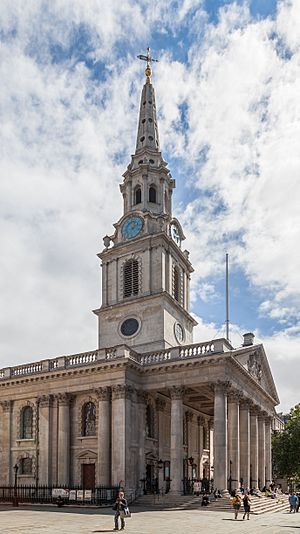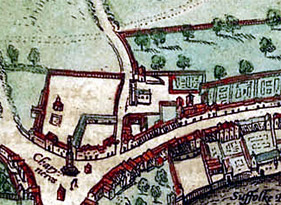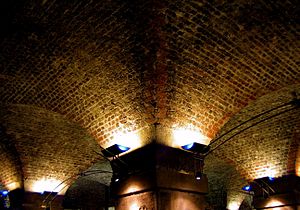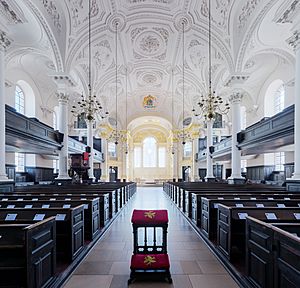St Martin-in-the-Fields facts for kids
Quick facts for kids St Martin-in-the-Fields |
|
|---|---|

The church in 2014
|
|
| Lua error in Module:Location_map at line 420: attempt to index field 'wikibase' (a nil value). | |
| Location | Trafalgar Square, Westminster London, WC2 |
| Country | England |
| Denomination | Church of England |
| Previous denomination | Catholic |
| History | |
| Status | Parish church |
| Dedication | Saint Martin |
| Architecture | |
| Functional status | Active |
| Heritage designation | Grade I |
| Architect(s) | James Gibbs |
| Architectural type | Church |
| Style | Neoclassical |
| Years built | 1721–1726 |
| Specifications | |
| Number of spires | 1 |
| Spire height | 192 feet (59 m) |
| Bells | 12 (full circle) |
| Tenor bell weight | 29 long cwt 1 qr 1 lb (3,277 lb or 1,486 kg) |
| Administration | |
| Deanery | Westminster (St Margaret) |
| Archdeaconry | London (previously Charing Cross) |
| Diocese | London |
| Province | Canterbury |
St Martin-in-the-Fields is a famous Church of England church. It stands at the north-east corner of Trafalgar Square in London. The church is named after Saint Martin of Tours. There has been a church on this spot for many centuries. Long ago, this area was just open fields outside the old London wall.
As London grew, this church became very important. The old church building was getting old and weak. So, a new one was built between 1722 and 1726. It was designed by James Gibbs in a style called Neoclassical. This church is now a key part of the look of Trafalgar Square.
Contents
History of the Church
Ancient Times
In 2006, archaeologists found old burials at the church site. These burials were from around 350 AD. One special burial was a sarcophagus from about 410 AD. This area was outside Roman London, which was normal for burials. But it was quite far out, about a mile from the city. This discovery makes historians rethink how important Westminster was back then. Some think it might have been an early Christian center.

The Saxon people also used this area as a burial ground. It's rare for a place to be used for burials for such a long time. It's possible that the Saxon town of Lundenwic grew from this ancient burial site.
Medieval and Tudor Periods
The first mention of the church was in 1222. There was a disagreement between the Abbot of Westminster and the Bishop of London. They both wanted control over the church. The Archbishop of Canterbury decided that Westminster Abbey should control it.
King Henry VIII rebuilt the church in 1542. He did this so that people with the plague wouldn't have to walk through his Palace of Whitehall. At that time, the church was truly "in the fields." It was alone between the cities of Westminster and London.
The 1600s
By the time King James I was in power, many more people lived in the area. The church building was too small for everyone. In 1606, the king gave land for a new churchyard. The church was then made bigger towards the east. It was also "repaired and beautified." Later in the 1600s, more space was added by building galleries inside. New churches were also built nearby, which helped reduce the crowds at St Martin's.
At the start of the 1700s, the church was made of brick with stone parts. It had a tiled roof and a stone tower. The inside had wooden walls and galleries. The church was about 84 feet long and 62 feet wide. The tower was about 90 feet tall. Many famous people were buried here, including scientist Robert Boyle and actress Nell Gwyn.
Building the New Church
In 1710, a check showed that the church walls and roof were falling apart. In 1720, the government passed a law to rebuild the church. Money was collected from the people living in the area. A temporary church was set up nearby. People were told they could move their relatives' graves if they wished.
The rebuilding team chose James Gibbs to design the new church. He first suggested a round church with a dome. But this idea was too expensive. Gibbs then drew a simpler, rectangular plan, which was accepted. The first stone was laid on March 19, 1722. The last stone of the spire was put in place in December 1724. The whole project cost about £33,661.
The front of St Martin's has a grand entrance with tall columns. Gibbs was inspired by other architects like Christopher Wren. But Gibbs made the tower a part of the church's main building. It rises right behind the front entrance. The spire of St Martin's is 192 feet tall.
The church inside is rectangular. The main area, called the nave, is separated from the sides by columns. There are balconies, or galleries, on three sides. The ceiling is curved and decorated with cherubs and clouds.
Before Trafalgar Square was built in the 1820s, other buildings surrounded the church. People said its front would look better if the buildings in front were removed.
The design of St Martin's was copied a lot, especially in the United States. Even though Gibbs was secretly Catholic, his church design became popular for Protestant churches worldwide. Churches in Glasgow, Charleston (USA), Dublin, Chennai (India), and Cradock (South Africa) were all inspired by St Martin-in-the-Fields.
Many famous people were buried in the new church. These include sculptor Louis-François Roubiliac and furniture maker Thomas Chippendale. The churchyard to the south was later removed to make way for a new street. Two smaller parts of the churchyard remain. They were made into public gardens in 1887.
Modern Times

St Martin-in-the-Fields is one of London's most famous churches. It's known for helping homeless people. Vicar Dick Sheppard, who was in charge from 1914 to 1927, started programs for the homeless. He called it the "Church of the Ever Open Door." The church still helps young and homeless people today. They do this through "The Connection at St Martin-in-the-Fields."
The church's basement, called the crypt, has a café. This café hosts jazz concerts. The money from these concerts helps the church's programs. The crypt also has the London Brass Rubbing Centre. Here, you can make copies of old brass carvings. A statue of Henry Croft, London's first pearly king, is also in the crypt.
In 2006, a big project began to renew the church. It cost £36 million. The church and crypt reopened in 2008.
The current vicar is Sam Wells. He is a priest, a writer, and a theologian.
Twelve old bells from St Martin-in-the-Fields, made in 1725, are now in the Swan Bells tower in Perth, Australia. The church has a new set of twelve bells, made in 1988. They are rung every Sunday morning.
In Popular Culture
Because it's in central London, the church often appears in movies and TV shows. You can see it in films like Notting Hill and Enigma. It has also been in TV shows like Doctor Who and Sherlock.
The church is also mentioned in many books:
- 1850 – David Copperfield by Charles Dickens
- 1908 – A Room with a View by E. M. Forster
- 1949 – Nineteen Eighty-Four by George Orwell (where it becomes a military museum)
- 1949 – The Parasites by Daphne du Maurier
It's also in poems:
- 1893 – "The Kingdom of God" by Francis Thompson
- 2009 – "Now traveller, whose journey passes through" by Andrew Motion
Some people believe the church is the "St Martin's" mentioned in the nursery rhyme "Oranges and Lemons."
Royal Connections
The church has a special link with the Royal Family. It is their local parish church. It also has ties to 10 Downing Street and the Admiralty.
Charity Work
The St Martin-in-the-Fields charity helps people who are homeless or at risk of becoming homeless. Since 1920, the church has raised money for vulnerable people with its annual Christmas Appeal. The BBC Radio 4 Appeal has broadcast this appeal every December since 1927.
"The Connection at St Martin's" is a charity located next to the church. It works closely with the church. Each year, it helps about 4000 homeless people in London. They offer places to stay, medical care, training, and fun activities.
Music at the Church
The church is well-known for its concerts. Many music groups perform there. One famous group is the Academy of St Martin-in-the-Fields. It was started by Sir Neville Marriner and John Churchill, who used to be the Master of Music at St Martin's.
The Organ
The church organ is located in the west gallery. The first organ in the new church was built in 1727. The organ used today was built in 1990.
St Martin's School
In 1699, the church started a school for poor boys. Later, it became a girls' school. It was first near the church in Charing Cross Road. It is now called St Martin-in-the-Fields High School for Girls. In 1928, it moved to its current location in Lambeth.
The school's badge shows Saint Martin of Tours. Its Latin motto is Caritate et disciplina, which means "With love and learning." It is a Christian school, but it welcomes girls of all faiths.
See also
 In Spanish: St Martin-in-the-Fields para niños
In Spanish: St Martin-in-the-Fields para niños





